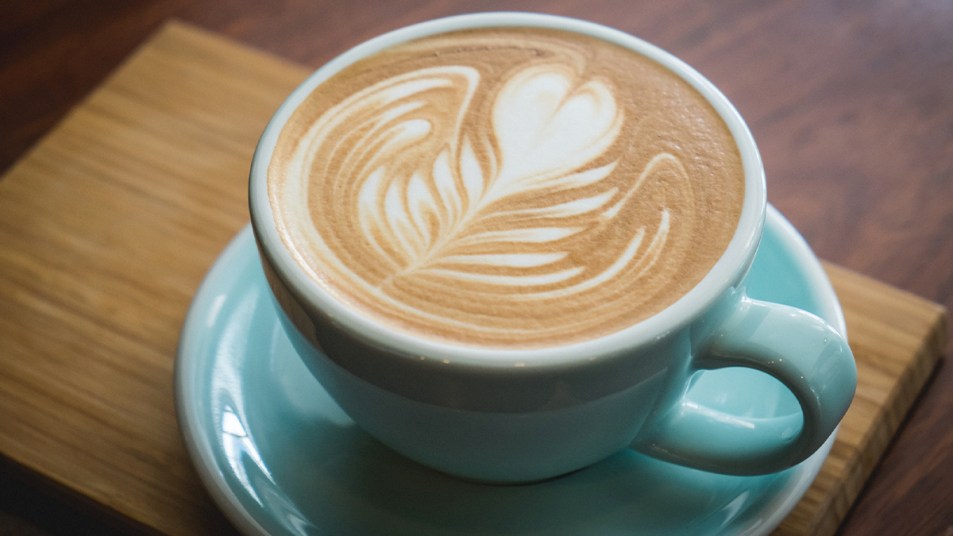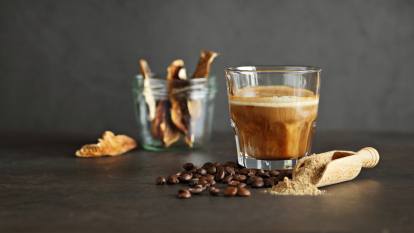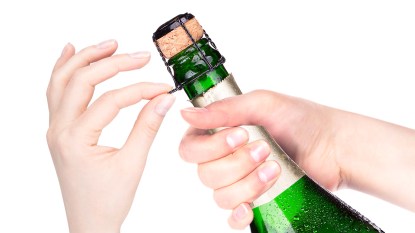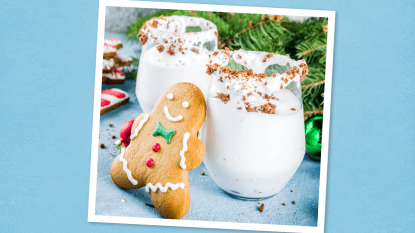How to Make a Latte at Home That’s Just as Tasty as From the Coffee Shop

When those caffeine cravings hit, it’s tempting to make a trip to your favorite coffee shop for a a caffeinated treat. But learning how to make a latte at home means you can whip it up in minutes for a pick-me-up any time of the day! It’s also much cheaper, especially if you’re paying to customize it to your liking — those drinks can add up quick!
We understand it might seem daunting to make a latte yourself at first, but these tips and tricks can help you nail all the basics, from choosing the right espresso machine to actually preparing the drink!
What are the ingredients for a latte?
For the most part, lattes only require two ingredients: espresso and milk. That’s it! However, it’s becoming more common to see lattes that are made with matcha powder or spices like turmeric instead of coffee. These are great if you want a soothing drink without the jitteriness of caffeine (and to help shed a few pounds).
Plus, alternatives milks like oat and coconut varieties are starting to take the place of regular milk as tasty non-dairy options. Of course, one thing that hasn’t changed is adding sugar, natural sweeteners, or sprinkling of seasonings like cinnamon to mellow out the strong flavor of the espresso. It’s up to each individual, so let your taste buds take over while making a latte at home!
Can you make a latte with regular coffee?
Regular coffee is great for a plain cup of joe, but it doesn’t produce the same results as espresso for lattes. The key difference is that freshly brewed espresso has a reddish, brown foamy layer on top called the crema. It’s similar to the creamy part of Guinness when you first take a sip.
Lindsey Goodwin, food writer for The Spruce Eats, describes the crema as a sign that the espresso was made correctly. It also adds a well-rounded flavor to the espresso shot that’ll linger on your tastebuds longer than regular coffee.
She reassures us that it’s not worth getting the “crema blues” if the shot doesn’t turn out perfect every time. “Remember, the beans, roast, and machine play a big role, and one or all of those may not sway things in your favor,” she says.
You can buy pre-ground espresso beans from the store, but you might miss out on some flavor. They can quickly loses freshness as soon as they’re ground. Instead, think about sticking to whole beans and getting a coffee grinder, like Mueller Austria Coffee Grinder Mill (Buy on Amazon, $19.97). It’s an extra step, but also your best bet for making the tastiest lattes at home.
What’s the difference between a latte and a cappuccino?
A latte can easily get mixed up with a cappuccino because they look so similar. Different ratios of espresso to milk set them apart, though. Whether or not we realize it, this makes a huge difference in the flavor of each drink.
Joseph Monett, a barista at Cafe Grumpy in NYC, broke things down in a video for Business Insider. He mentions that lattes have a double shot of espresso with steamed milk and a light layer of foam. This ratio allows for the natural sweetness of the milk to mix with the espresso so that one isn’t overpowering the other.
Cappuccinos have the same amount of espresso, but less steamed milk and more foam. He notes that this gives cappuccino a stronger coffee flavor than a latte. Watch the explainer below to see how he walks through the differences between these and other popular coffee shop drinks:
How to Make a Latte With an Espresso Machine
Investing in an espresso machine is the key to recreating the lattes we love from the coffee shop. It’s basically an all-in-one appliance that’ll brew espresso shots and froth the milk for us. Fortunately, many espresso machines are on the smaller side, so they also won’t clutter our counter space (something we can all rejoice!).
Keep in mind that each espresso machine model is different, so the steps for making the drink will vary. Buying a Keurig latte maker (Buy on Amazon, $170.88) means you can pop a K-cup of ground espresso (Buy on Amazon, $20.79) into the machine and it’ll quickly brew the shot. Other models might require you to grind the espresso and fill it into the holder attachment (also called a portafilter) before inserting it into the machine.
It’s definitely worth researching which espresso machines would be best for you and getting familiar with what your latte prep might look like. If you need a place to start, check out our list for the best latte machines to help you get your caffeine fix at home.
Once you have your machine, you can follow this step-by-step guide for making a latte from the experts at Williams Sonoma:
- Prepare one or two shots of espresso, according to the manufacturer’s instructions, into an eight-ounce mug.
- Use the steam wand of your espresso machine, froth 1/2 cup of cold whole milk in a small pitcher (Buy on Amazon, $9.99) following the manual’s steps. It should reach a temperature of about 155 Fahrenheit where the milk is warm and has lots of small, tight bubbles.
- Gently tap the bottom of the steaming pitcher on your counter to pop any large bubbles that might’ve formed.
- Grab a spoon to hold back the foam on top and pour the steamed milk into the espresso. Once the milk starts getting to top of the glass, remove the spoon and start pouring a thin layer of foam on top to finish the drink.
- Serve the latte right away.
How do you make a latte without a frother?
If your espresso machine somehow doesn’t have a milk frothing feature, don’t fret. Reach into your kitchen cabinet and grab a mason jar to do it by hand. This neat tip comes from Food Network culinary editor Heath Goldman and it requires putting the milk into a jar and giving it a shake.
This trick creates the frothy milk texture in as little as a minute — and you’re getting in a mini-workout as you shake! Goldman suggests using nonfat or 2 percent milk because it produces more foam due to its lower protein content. Also, quickly microwaving it afterwards allows the milk to maintain its bubbly texture.
Follow her steps below to see how to make a latte without a milk frother:
- Brew two shots of espresso and pour each shot into a mug.
- Pour 2/3 cup of nonfat or 2 percent milk into a mason jar and cover it with the lid.
- Shake it vigorously for one minute until bubbles start to form.
- Uncover the jar and microwave for 30 seconds. The milk froth should rise to the top of the jar.
- Pour the frothed milk over the espresso. For a fun latte art effect, drag a toothpick through the foam to create tiny swirls.
- Drink it immediately.
How to Make an Iced Latte
A latte doesn’t always have to be served piping hot. With the summer heat here to stay for a bit, we’re going to need something chillier to sip on. An iced latte is the perfect refreshing drink to give us a caffeine boost when we need it.
Luckily, the team at Starbucks has a single-serving iced latte recipe on their blog, which is worth trying out at home:
- Add one cup of ice into a tall glass.
- Cover the ice with four ounces of freshly brewed espresso.
- Fill a mason jar with 3/4 cup whole milk and any sweetener. Seal the jar tightly and shake vigorously for one to two minutes. This will make the milk thick and frothy.
- Pour the foamy milk into espresso. Stir it with a straw or spoon to fully incorporate everything.
- Sip and enjoy!
Getting the hang of being an at-home barista takes some practice, but it can be a new and fun skill to start practicing! If you’re looking to experiment with other types of lattes, take a peek at our recipes for collagen lattes, the golden milk diet, and coconut milk lattes.













